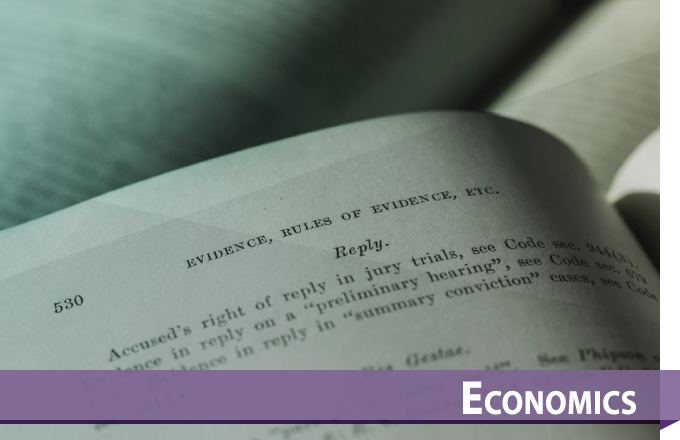Although research shows that competitive banks spur corporate growth, less is known about the impact of bank competition on corporate risk. Using a sample of more than 70,000 firm-year observations covering the period from 1975 through 1994, we find that deregulation that intensified competition among banks materially reduced corporate risk, especially among firms that rely heavily on bank finance. We find that competition-enhancing bank deregulation reduced corporate volatility by easing credit constraints when firms experience adverse shocks and reducing the procyclicality of borrowing.
February 2020
Journal of Corporate Finance
The lack of hard evidence in allegations about sexual misconduct makes it difficult to separate true allegations from false ones. We provide a model in which victims and potential libelers face the same costs and benefits from making an allegation, but the tendency for perpetrators of sexual misconduct to engage in repeat offenses allows semiseparation to occur, which lends credibility to such allegations. Our model also explains why reports about sexual misconduct are often delayed, and why the public rationally assigns less credibility to these delayed reports.
February 2020
American Economic Journal: Microeconomics
We study how vertical market structure affects the incentives of suppliers and customers to develop a new input that will enable the innovator to replace the incumbent supplier. In a vertical setting with an incumbent monopoly upstream supplier and two downstream firms, we show that vertical integration reduces the R&D incentives of the integrated parties, but increases that of the nonintegrated downstream rival. Strategic vertical integration may occur whereby the upstream incumbent integrates with a downstream firm to discourage or even preempt downstream disruptive R&D. Depending on the R&D costs, vertical integration may lower the social rate of innovation.
January 2020
Journal of Economics and Management Strategy
An agent performing risky experimentation can benefit from suspending it to learn directly about the state. ‘Positive’ information acquisition seeks news that would confirm the state that favours experimentation. It is used as a last-ditch effort when the agent is pessimistic about the risky arm before abandoning it. ‘Negative’ information acquisition seeks news that would demonstrate that experimentation is futile. It is used as an insurance strategy to avoid wasteful experimentation when the agent is still optimistic. A higher reward from risky experimentation expands the region of beliefs that the agent optimally chooses information acquisition rather than experimentation.
January 2020
The Economic Journal
In an environment subject to random fluctuations, when does an increase in the breadth of activities in which individuals interact together help foster collaboration on each activity? We show that when players, on average, prefer to stick to a cooperative agreement rather than reneging by taking their privately optimal action, then such an agreement can be approximated as equilibrium play in a sufficiently broad relationship. This is in contrast to existing results showing that a cooperative agreement can be sustained only if players prefer to adhere to it in every state of the world. We consider applications to favor exchange, multimarket contact, and relational contracts.
January 2020
Games and Economic Behavior
本研究考察了社會排斥對消費者視覺密度偏好的影響。基於七項實驗研究,我們發現認為自己被社會排斥的消費者與不感到被排斥的人相比,對有密集圖案產品的評價更正面。之所以會出現這個現象,是因為社會排斥會引發一種心理的空虛感,而密集的圖案提供了一種「被填滿」的感覺,有助緩解空虛感。當消費者進行填充某些物品的動作或體驗到「時間密度」的感覺(即一個排得滿滿的日程,需於短時間内完成許多工作)時,這種效果會減弱。研究結果揭示了消費者基於社會因素對產品所形成的審美偏好,為營銷人員、設計師和政策制定者帶來實際參考價值。
December 2019
Journal of Consumer Research
Using brokerage mergers and closures as natural experiments, we examine how exogenous changes in the information environment affect a firm’s financing choice. Our difference-in-differences approach shows that exogenous increases in information asymmetry lead firms to substitute away from equity and public debt toward bank debt. Firms with higher risk tend to substitute equity for bank debt, and firms with lower risk tend to substitute bonds for bank debt. The effect of the change in the information environment on a firm’s financing choice is more pronounced for firms with worse information environments, such as those with few initial analysts and younger firms. We demonstrate that the mechanism of the change is through a reduction of the issuance of equity and bonds but with an increase of the issuance of bank loans. Further analysis reveals that such firms tend to reduce long-term borrowing, reduce their issuance of subordinated debt, and increase their revolving credit lines.
December 2019
Management Science
We analyze the design and performance of equity auctions when bidder's valuations and opportunity costs are private information, distributed according to an arbitrary joint density that can differ across bidders. We identify, for any incentive compatible mechanism, an equivalent single-dimensional representation for uncertainty. We then characterize the revenue-maximizing and surplus-maximizing equity mechanisms, and compare revenues in optimal equity and cash auctions. Unlike in cash auctions, the adverse selection arising from bidders' two-dimensional types in equity auctions can lead to a global violation of the regularity condition, which represents a maximal mismatch between incentive compatibility and maximization of revenue or surplus. Such mismatch can lead a seller to exclude bidders and demand a bidder-specific stake from a non-excluded bidder, providing insights into when a firm should employ an auction and when it should just negotiate with a single bidder.
November 2019
Journal of Economic Theory
The rise of credit default swaps (CDS) provides creditors with a market-based approach to obtaining protection, but it can also affect lenders' monitoring of the borrowers. We find that after CDS begin trading on a given firm, new loans to that firm are less likely to require collateral and have less strict financial covenants, even controlling for endogeneity. The effects are stronger when lenders have easier access to CDS, for safer firms, credit lines, and performance-based covenants. Our evidence is consistent with the theory that the introduction of CDS trading makes loan contracting more effective for better quality borrowers.
November 2019
Journal of Accounting and Economics

























